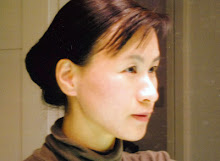Actually, most of horses in our world are domestic and termed. I've seen some wild horses in United States originally came from Spain about 300 years ago. They were as if be born to cultivate soil for farming. They didn't look like thoroughbreds at all. They had strong legs. Therefore, before I visit Horse Guard Parade, I imagined horses something in between thoroughbred and wild horse. I also imagined the animal lacking emotion simply because they are trained for war. The life with an apparent absence of emotion makes me think always.
 Oh, the horse is so gentle...
Oh, the horse is so gentle...




